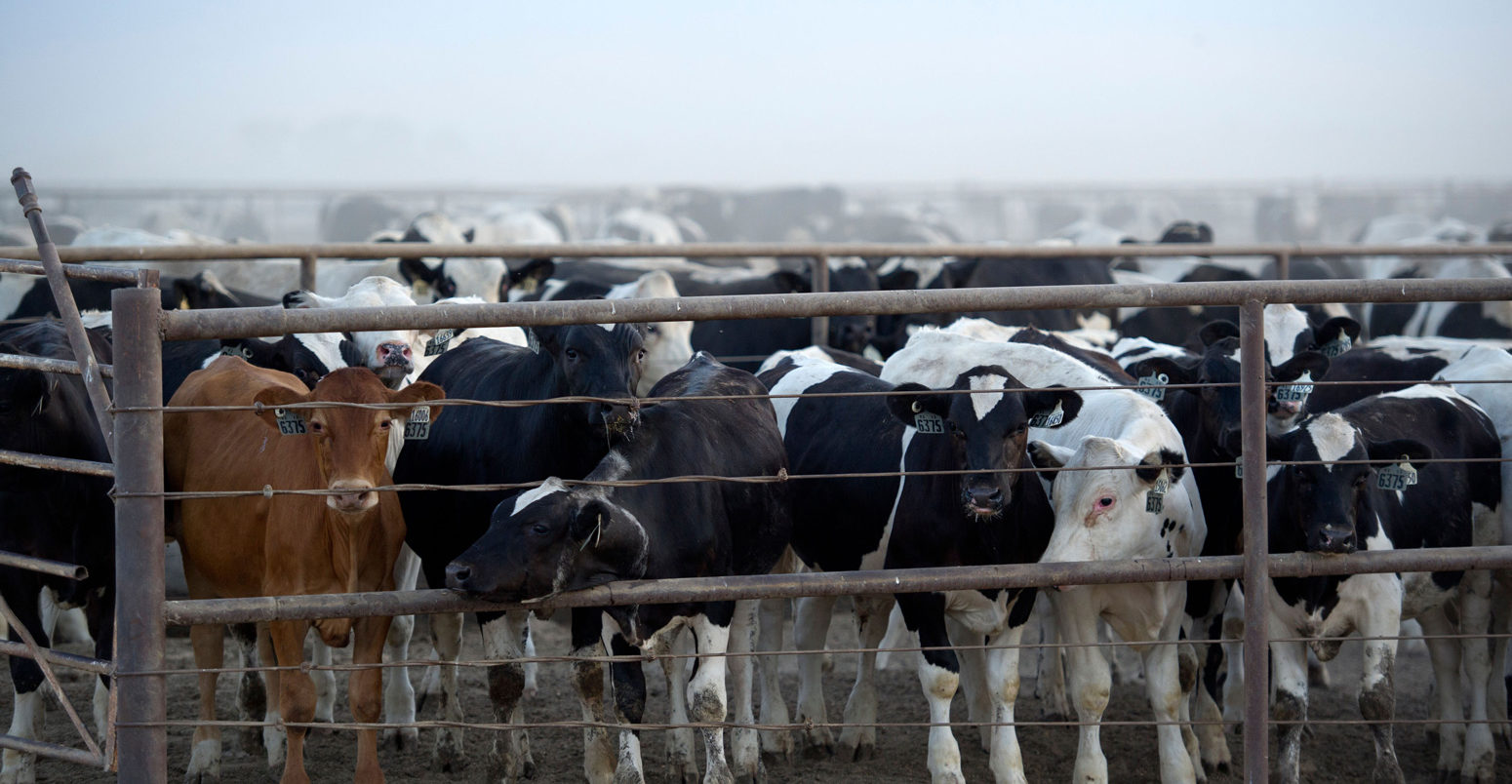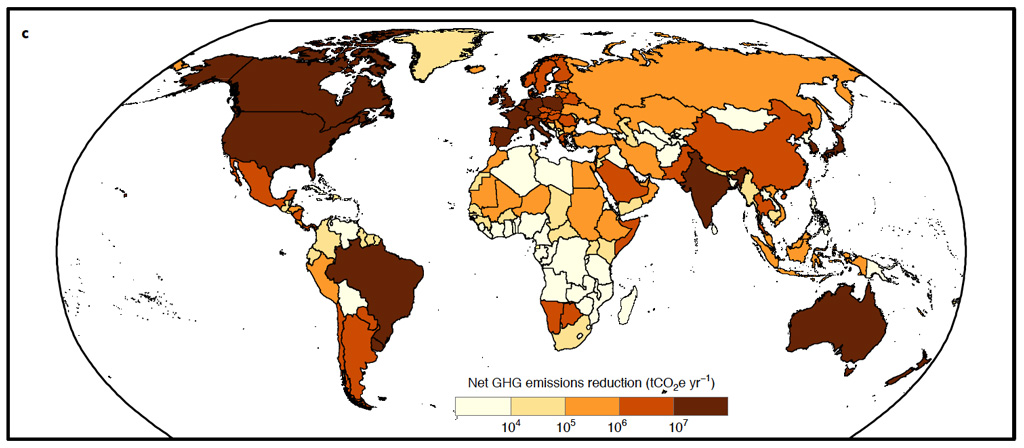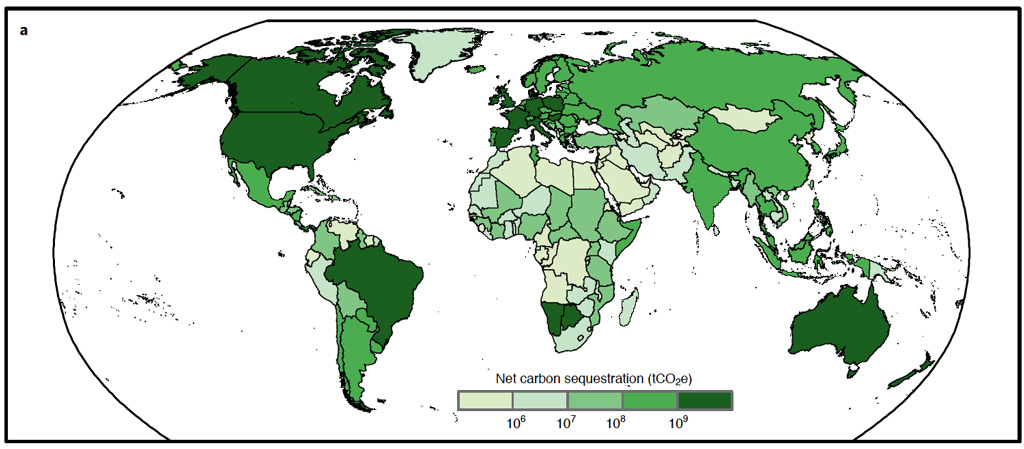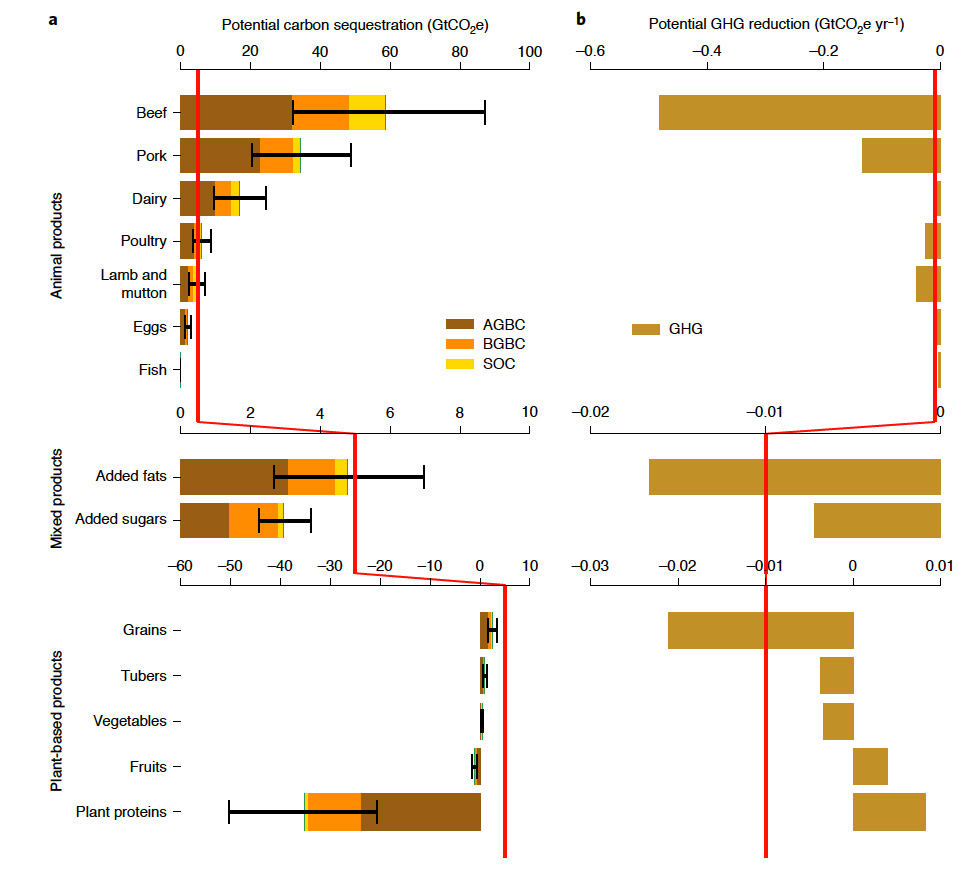
Rich nations could see ‘double climate dividend’ by switching to plant-based foods
Ayesha Tandon
01.10.22Ayesha Tandon
10.01.2022 | 4:00pmAdopting a more plant-based diet could give rich countries a “double climate dividend” of lower emissions and more land for capturing carbon, a new study says.
Animal-based foods have higher carbon and land footprints than their plant-based alternatives, and are most commonly consumed in high-income countries. The study, published in Nature Food, investigates how the global food system would change if 54 high-income countries were to shift to a more plant-based diet.
High-income countries could cut their agricultural emissions by almost two-thirds through dietary change, the authors find. They add that moving away from animal-based foods could free up an area of land larger than the entire European Union.
If this land were all allowed to revert to its natural state, it would capture almost 100bn tonnes of carbon – equal to 14 years of global agricultural emissions – the authors note. They add that this level of carbon capture “could potentially fulfil high-income countries’ CO2 removal obligations needed to limit warming to 1.5C under equality sharing principles”.
The US, France, Australia and Germany would collectively see roughly half of the total carbon benefits, the study notes, because meat and dairy production and consumption are high in these countries.
‘Double climate dividend’
Feeding the world’s population of almost eight billion people is no small task. The global food system is responsible for around one-third of all human-caused greenhouse gas emissions, and half of the planet’s habitable land is used to produce food.
However, not all calories have an equal impact on the planet. On average, animal-based foods produce 10-50 times more emissions than plant-based foods. Meanwhile, livestock takes up nearly 80% of global agricultural land, despite producing less than 20% of the world’s supply of calories.
Individuals in high-income nations currently have the greatest potential to reduce greenhouse gas emissions through their dietary choices, because their diets are usually the most meat-orientated. Animal-derived products drive 70% of food-system emissions in high-income countries but only 22% in low–middle-income countries.
(In 2019, Carbon Brief produced a week-long series of articles on food systems, including a discussion of the climate impacts of meat and dairy, and expert views on how changing diets are expected to affect the climate.)
The study explores how the carbon footprint of food production could change if 54 high-income countries were to adopt the EAT-Lancet planetary health diet. This is a mainly plant-based diet that is “flexible by providing guidelines to ranges of different food groups that together constitute an optimal diet for human health and environmental sustainability”.
Dr Paul Behrens from Leiden University, an author on the paper, tells Carbon Brief that the diet varies between countries to account for their “local production and food cultures”.
The study investigates the immediate reduction in emissions from adopting the EAT-Lancet diet using a dataset from the 2010 Food and Agriculture Organization’s statistical Database, linked at the national level to the Food and Agriculture Biomass Input–Output dataset (FABIO).
The authors also determine how much land could be spared by a shift in diet. They use global crop and pasture maps – combined with soil carbon and vegetation maps – to quantify how much extra carbon could be drawn down by soil and vegetation if this surplus land were allowed to revert to its natural state of mixed native grassland and forest.
As well as investigating changes in the 54 high-income countries, the study follows the trade of food between nations to see how dietary shifts in one country can affect the food-related land and carbon footprints around the world.
The analysis is performed for the 54 high-income countries available in FABIO. For example, Chile is considered a high-income country, while India is not.
The map below shows the drop in greenhouse gas emissions from global agriculture if the 54 high-income countries were to shift to the EAT-Lancet planetary health diet. Dark red shading indicates the largest reductions. Changes in lower-income countries are due to knock-on impacts for food trade.

According to the study, high-income nations could reduce their agricultural emissions by 62% by shifting to a more plant-based diet. Dr Sonja Vermeulen is the lead global food scientist at WWF, and is not involved in the study. She helped to put this figure into perspective:
“To put this in perspective, it’s about the same positive impact as all countries signing up to and implementing the COP26 declaration on the transition to 100% zero emission cars and vans globally by 2040.”
Freeing up land
The study finds that moving away from animal-based foods could free an area of land larger than the entire European Union. If this area were allowed to revert to its natural state, it would capture around 100bn tonnes of carbon – equal to 14 years of global agricultural emissions from 2010 – by the end of the century, the authors find.
The map below shows the potential carbon sequestration from surplus land if the 54 high-income countries were to shift to the EAT-Lancet planetary health diet, with dark green shading indicating the largest potential. Changes in lower-income countries are due to knock-on impacts for food trade.

Approximately half of the carbon benefit from cutting emissions and increasing carbon sequestration could be seen collectively in the US, France, Australia and Germany, the study says.
The authors also highlight that, according to past research, limiting warming to 1.5C above pre-industrial levels requires the 54 high-income countries in this analysis to achieve cumulative CO2 removals of 85-531bn tonnes of CO2 by the end of the century. This range comes from uncertainty in the amount of CO2 removal required, and in the amount that should be allocated to each country.
Based on these numbers, the study concludes that the 100bn carbon sequestration “could potentially fulfil high-income countries’ CO2 removal obligations needed to limit warming to 1.5C under equality sharing principles”.
The study finds that many low and mid-income countries – such as Brazil, India and Botswana – would export less food to high-income nations if they consumed less meat. This would reduce their own agricultural emissions and free up land for drawing down carbon, despite no dietary changes in their own countries, the researchers say. (The study does not assess the economic impact of this reduced trade.)
Around two-thirds of the carbon sequestration potential from dietary changes in high-income countries is domestic, the study finds. Meanwhile, almost a quarter is located in other high-income countries and around an eighth is from low and middle income countries.
Dr Nynke Schulp is an associate professor of land use, lifestyle and ecosystem change at the Vrije Universiteit Amsterdam, and was not involved in the study. She tells Carbon Brief that existing studies “tend to work from the assumption that the whole world adopts a specific dietary change”, and so “this study’s focus on dietary change in high-income nations is an important nuance, both from a mitigation potential perspective and from a climate justice perspective”.
Capturing carbon
The study assumes that any land freed up by a change in diet would be allowed to revert to its natural state through a “natural climate solution” called passive restoration, in which land is allowed to revert to its past state. Behrens explains in a press release that this technique has a range of co-benefits, including “water quality, biodiversity, air pollution and access to nature, to name just a few”.
The study breaks down the carbon sequestration potential of passive restoration into three categories: aboveground biomass carbon (AGBC), belowground biomass carbon (BGBC) and soil organic carbon (SOC) stocks. These refer to carbon held in plant matter above the soil, plant matter below the soil, and the soil itself, respectively.
The plot below shows the total carbon sequestration (left) and emissions reductions (right) potentials from a range of different food types. The red lines on the left and right mark fixed values to make comparisons between the charts easier. Note that carbon sequestration is shown as a total over the 21st century, while the reduction in emissions is shown per year.

The plot shows that animal-based products – most notably beef – have high carbon and land footprints. The authors highlight that the US and Australia in particular would see benefits from reducing their beef intake, due to their high domestic production and consumption.
Vermeulen tells Carbon Brief that changing diets in these countries could “transform” them:
“The term ‘food system transformation’ is perhaps often used too lightly – but there can be no doubt that the changes in these places would constitute total transformation of local economies, landscapes and cultures. Imagine the vast cattle ranches of the US and Australia replaced with equally vast rewilded or repurposed lands – would these be used for biomass and bioenergy, or conservation and biodiversity, and how would rural communities create new livelihoods for themselves?”
Dietary choices
High-income countries could see the largest per-capita carbon reductions by shifting to a planet-friendly diet, the study concludes. However, asking individuals to take charge of their personal carbon footprints can be a controversial area of discussion.
For example, the authors note that alcoholic beverages and “stimulants” including coffee, cocoa products and tea comprise 5.8% of dietary greenhouse gas emissions. These “luxury, low-nutrition crops” are predominantly consumed in high-income countries and present a “non-negligible” opportunity for cutting emissions and capturing carbon, according to the study. However, “sociological and policy complications” would make it difficult to reduce consumption of these products in practice, the authors say.
They also highlight that eating more offal – a co-product of meat production – could be a good way for individuals to reduce their meat-related carbon footprints. However, the authors say that offal is “not typically consumed in high-income nations due to convention and consumer preference”.
Dr Matthew Hayek is an assistant professor in the Department of Environmental Studies at NYU arts and science, who was not involved in the study. He tells Carbon Brief how governments could incentivise individuals to eat more sustainably:
“Folks in developed countries eat far more meat and dairy than the global average… Reducing emissions from food consumption in rich countries is critical. For consumers who have ample food choices, these choices play a sizable role in contributing to our climate goals. Our policies must reflect this by making healthy and sustainable food choices more prevalent, convenient, and inexpensive.”
And Behrens tells Carbon Brief that “the onus is on high-income nations to transform food systems”. In the press release, he adds:
“It will be vital that we redirect agricultural subsidies to farmers for biodiversity protection and carbon sequestration. We must look after farming communities to enable this in a just food transition. We don’t have to be purist about this, even just cutting animal intake would be helpful. Imagine if half of the public in richer regions cut half the animal products in their diets, you’re still talking about a massive opportunity in environmental outcomes and public health.”
Sun, Z. et al. (2022) Dietary change in high-income nations alone can lead to substantial double climate dividend, Nature Food, doi: 10.1038/s43016-021-00431-5
-
Rich nations could see ‘double climate dividend’ by switching to plant-based foods

